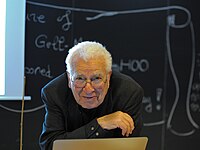d夸克
| 组成 | 基本粒子 |
|---|---|
| 系 | 费米子 |
| 代 | 第一代 |
| 基本相互作用 | 强, 弱, 电磁力, 重力 |
| 符号 | d |
| 反粒子 | 反d夸克 ( d ) |
| 理论 | 默里·盖尔曼(1964) 乔治·茨威格(1964) |
| 发现 | SLAC(1968) |
| 质量 | 4.8+0.5 −0.3 MeV/c2[1] |
| 衰变粒子 | 稳定或u夸克 + 电子 + 反电中微子 |
| 电荷 | -1/3 e |
| 色荷 | 有 |
| 自旋 | 1/2 |
| 弱同位旋 | LH: −1/2, RH: 0 |
| 弱超荷 | LH: 1/3, RH: −2/3 |
d夸克(down quark,台湾译下夸克,中国大陆又称“下夸克”[注 1])是一种基本粒子。在所有的夸克中,d夸克是质量第二小的夸克,只比u夸克的质量大。组成原子核的中子与质子都是由d夸克与u夸克共同形成。d夸克属于第一代粒子,电荷为−1/3e,裸质量为4.8+0.5
−0.3 MeV/c2[1]。和所有夸克一样,d夸克是一种费米子,自旋为1/2,且可以感受到所有四种基础作用:引力相互作用、电磁相互作用、强相互作用与弱相互作用。d夸克的反粒子是反d夸克。d夸克带有负电荷,反d夸克带有正电荷。
1964年,默里·盖尔曼与乔治·茨威格假设d夸克的存在,这是使用八重道来对于强子分类所得到的后果预测。后来,物理学者在斯坦福直线加速器中心所做的实验观测证实了d夸克的存在。
历史
[编辑]

在粒子物理学初期(二十世纪前半期),质子、中子、π介子等等强子类粒子都被认为是基本粒子。然而随着更多强子被发现,粒子园从1930年代早期与1940年代的几个粒子增加到1950年代的几十个粒子。物理学者起初并不清楚它们彼此之间的关系,直到1961年,由于默里·盖尔曼[3]与尤瓦尔·内埃曼[4]各自独立地提出一种强子分类方案,称为“八重道”,利用SU(3)味对称性,这问题才获得解决。
八重道将强子组织为不同的同位旋多重态,然而,物理学者仍不清楚这分类方案背后的物理原理。1964年,盖尔曼[5]与乔治·茨威格[6][7]各自独立的提出夸克模型,在那时只涉及到u夸克、d夸克与s夸克。[8]尽管夸克模型能够合理地解释八重道,但在那时并没有任何实验证据。1968年,物理学者在斯坦福直线加速器中心所做的实验观测,终于证实了d夸克的存在。[9][10]深度非弹性碰撞实验揭示了质子具有次结构:它是由三个更基础的粒子组成,因此证实了夸克模型。[11]
刚开始,人们并不情愿把这三个基础粒子辨识为夸克,而是青睐理查·费曼的部分子模型。[12][13][14]随着时间演进,夸克模型渐渐被广泛接受(更多细节,请参阅条目J/ψ介子)。[15]
质量
[编辑]虽然d夸克很常见,但d夸克的裸质量尚未被准确测定,应该是在4.5与5.3MeV/c2之间。[1]格点QCD方法所预测的数值更为精确:4.79±0.16 MeV/c2。[16]
在介子(由一个夸克与一个反夸克组成的粒子)或重子(由三个夸克组成的粒子)里,夸克的有效质量会变得比较大,这都归因于夸克与夸克之间的胶子场所产生的结合能。例如,在质子里,d夸克的有效质量约为330 MeV/c2。由于d夸克的裸质量很小,它不能直接地被计算出来,因为必须将相对论效应纳入考量。胶子场所媒介的强作用力之作用下,夸克的移动速度约为光速的99.995%,相应的洛伦兹因子约为100,所以,所有夸克的静质量总和仅为质子或中子质量的1%。
参阅
[编辑]注释
[编辑]参考文献
[编辑]- ^ 1.0 1.1 1.2 J. Beringer (Particle Data Group); et al. PDGLive Particle Summary 'Quarks (u, d, s, c, b, t, b′, t′, Free)' (PDF). Particle Data Group. 2013 [2013-07-23]. (原始内容 (PDF)存档于2013-10-22).
- ^ 物理学名词审定委员会.物理学名词 [S/OL].全国科学技术名词审定委员会,公布. 3版.北京:科学出版社, 2019: 374. 科学文库.
- ^
M. Gell-Mann. The Eightfold Way: A theory of strong interaction symmetry. M. Gell-Mann, Y. Ne'eman (编). The Eightfold Way. Westview Press. 2000: 11 [1964]. ISBN 0-7382-0299-1.
Original: M. Gell-Mann. The Eightfold Way: A theory of strong interaction symmetry. Synchrotron Laboratory Report CTSL-20 (California Institute of Technology). 1961. - ^
Y. Ne'eman. Derivation of strong interactions from gauge invariance. M. Gell-Mann, Y. Ne'eman (编). The Eightfold Way. Westview Press. 2000 [1964]. ISBN 0-7382-0299-1.
Original Y. Ne'eman. Derivation of strong interactions from gauge invariance. Nuclear Physics. 1961, 26 (2): 222. Bibcode:1961NucPh..26..222N. doi:10.1016/0029-5582(61)90134-1. - ^ M. Gell-Mann. A Schematic Model of Baryons and Mesons. Physics Letters. 1964, 8 (3): 214–215. Bibcode:1964PhL.....8..214G. doi:10.1016/S0031-9163(64)92001-3.
- ^ G. Zweig. An SU(3) Model for Strong Interaction Symmetry and its Breaking. CERN Report No.8181/Th 8419. 1964.
- ^ G. Zweig. An SU(3) Model for Strong Interaction Symmetry and its Breaking: II. CERN Report No.8419/Th 8412. 1964.
- ^ B. Carithers, P. Grannis. Discovery of the Top Quark (PDF). Beam Line (SLAC). 1995, 25 (3): 4–16 [2008-09-23]. (原始内容存档 (PDF)于2016-12-03).
- ^ E. D. Bloom; Coward, D.; Destaebler, H.; Drees, J.; Miller, G.; Mo, L.; Taylor, R.; Breidenbach, M.; et al. High-Energy Inelastic e–p Scattering at 6° and 10°. Physical Review Letters. 1969, 23 (16): 930–934. Bibcode:1969PhRvL..23..930B. doi:10.1103/PhysRevLett.23.930.
- ^ M. Breidenbach; Friedman, J.; Kendall, H.; Bloom, E.; Coward, D.; Destaebler, H.; Drees, J.; Mo, L.; Taylor, R.; et al. Observed Behavior of Highly Inelastic Electron–Proton Scattering. Physical Review Letters. 1969, 23 (16): 935–939. Bibcode:1969PhRvL..23..935B. doi:10.1103/PhysRevLett.23.935.
- ^ J. I. Friedman. The Road to the Nobel Prize. Hue University. [2008-09-29]. (原始内容存档于2008-12-25).
- ^ R. P. Feynman. Very High-Energy Collisions of Hadrons. [Physical Review Letters. 1969, 23 (24): 1415–1417. Bibcode:1969PhRvL..23.1415F. doi:10.1103/PhysRevLett.23.1415.
- ^
S. Kretzer; Lai, H.; Olness, Fredrick; Tung, W.; et al. CTEQ6 Parton Distributions with Heavy Quark Mass Effects. Physical Review D. 2004, 69 (11): 114005. Bibcode:2004PhRvD..69k4005K. arXiv:hep-ph/0307022
 . doi:10.1103/PhysRevD.69.114005.
. doi:10.1103/PhysRevD.69.114005.
- ^ D. J. Griffiths. Introduction to Elementary Particles. John Wiley & Sons. 1987: 42. ISBN 0-471-60386-4.
- ^ M. E. Peskin, D. V. Schroeder. An introduction to quantum field theory. Addison–Wesley. 1995: 556. ISBN 0-201-50397-2.
- ^ Cho, Adrian. Mass of the Common Quark Finally Nailed Down. Science Magazine. April 2010 [2018-07-11]. (原始内容存档于2012-03-06).
进阶阅读
[编辑]- A. Ali, G. Kramer; Kramer. JETS and QCD: A historical review of the discovery of the quark and gluon jets and its impact on QCD. European Physical Journal H. 2011, 36 (2): 245. Bibcode:2011EPJH...36..245A. arXiv:1012.2288
 . doi:10.1140/epjh/e2011-10047-1.
. doi:10.1140/epjh/e2011-10047-1. - R. Nave. Quarks. HyperPhysics. Georgia State University, Department of Physics and Astronomy. [2008-06-29]. (原始内容存档于2015-09-05).
- A. Pickering. Constructing Quarks. University of Chicago Press. 1984: 114–125. ISBN 0-226-66799-5.
